
Kirsten McCarthy / Cats.com
Have you ever wondered why some cats have long hair and other cats have short hair? Why do some cats have straight hair while others have curly hair or even no hair at all? Why are some cats brown with stripes while others are black tuxedo patterned, and still others are colorpointed like the Siamese?
What a cat’s coat looks like is determined by key genes that dictate the fur’s color, pattern, length, and texture. Genes are like blueprints—they spell out how big they will grow, what kind of fur they will have, what color their eyes will be, what color the coat will be, and much more.
Cats have about 20,000 genes, and about 10 to 15 genes and their alleles (different versions of those genes) determine the appearance of a cat’s coat. Cat coat genetics are extremely complex, but we can get a basic idea of how genes influence a cat’s color, pattern, coat length, and texture by exploring some of the main genes involved.
Genes That Affect Coat Color

Black is a dominant color. Kirsten McCarthy / Cats.com
Cats come in many beautiful hues, including black, white, brown, orange, gray, cream, and more. A handful of genes and their alleles determine the color of a cat’s coat, as well as the intensity of the pigmentation. These are:
Black and Brown

The B gene, also called the brown locus, determines coat color in cats—those with at least one dominant allele (B/B or B/b) will have black fur. AnnaDona / shutterstock.com
Also known as the brown locus, the B gene affects how much brown pigment appears in the coat. Cats with at least one copy of the dominant allele B (B/B or B/b) will be black. There are also two recessive alleles: b, which codes for chocolate (a richer brown shade) and bl, which codes for cinnamon (a warmer brown shade). Cats need two recessive alleles to be brown or cinnamon.
Orange (Red)

The dominant variation of the O gene causes a cat to be orange. Kirsten McCarthy / Cats.com
Also known as the orange locus, the O gene affects how much red pigment appears in the coat. The dominant allele, O, codes for orange. The recessive allele, o, codes for non-orange colors (black, chocolate, or cinnamon).
The O gene is located on the X chromosome, which makes things interesting depending on whether a cat is male or female. Far more orange cats are male than female. To understand why this happens, remember that females have two X chromosomes (XX) and males have one X chromosome and one Y chromosome (XY). Males only need one copy of the dominant O allele on their single X chromosome to be orange.
Females need two copies of the O allele—one on each of their two X chromosomes. Statistically, it’s more likely for males to be orange, though one in three orange cats is female.
Tortoiseshell and Calico

Calico cats have genetic coding for two colors—orange and black or brown—plus a gene that causes white markings. Bianca Grueneberg / Shutterstock.com
Although we consider tortoiseshell and calico to be patterns, the genetics behind tortoiseshell and calico is linked to the genes that control black and orange color. As with the color orange, tortoiseshell and calico are sex-linked—these color patterns are almost exclusively seen in female cats.
As we just discussed, the O gene is located on the X chromosome. Since male cats only have one X chromosome, they only have one copy of the O gene—either the dominant O allele (which codes for orange) or the recessive o allele (which codes for non orange colors—black, brown, or cinnamon).
Female cats, on the other hand, have two X chromosomes. This means they can have the dominant O allele on one X chromosome and the recessive o allele on the other X chromosome. In that case, they will be both orange and non-orange, resulting in tortoiseshell or calico (tortoiseshell with white markings).
Very rarely, male cats can be tortoiseshell or calico. These boys are born with an extra X chromosome (XXY). These cats have a genetic condition called Klinefelter syndrome, and are always sterile (they cannot reproduce).
White

The dominant form of the W gene overrides all over colors, making the cat solid white. Kirsten McCarthy / Cats.com
Called the white masking gene, the dominant W allele codes for white. Cats with at least one copy of the W allele (W/W or W/w) will be solid white. This dominant form of the gene overrides any other genes for color or pattern the cat might have.
Dilute Colors

When cats have two copies of the recessive allele of the dilution gene (d/d), black colors fade to gray and orange colors fade to cream. KRxMedia / Shutterstock.com
Known as the dilution gene, having at least one copy of the dominant allele D (D/D or D/d) results in deep color, for example, black or orange. Two copies of the recessive allele d (d/d) results in lighter, or diluted color, for example black to gray or orange to cream.
Genes That Affect Coat Pattern and Markings
Unless they are completely solid colored, cat coats of all colors can come in several beautiful patterns. Depending on which genes they have, a brown cat can have stripes, swirls, or spots; a black cat can have white spots; and a cream cat can have darker points of color on their extremities.
Tabby

Margarett24 / Shutterstock.com
The A gene, called the agouti gene, determines if a cat will have a tabby pattern. Cats with at least one copy of the dominant A allele (A/A or A/a) will display one of the tabby patterns.
For cats that have the dominant A allele, the tabby locus, or T gene, determines which type of tabby pattern a cat will have. The dominant TaM allele (TaM/TaM or TaM/tab) codes for mackerel tabby (stripes) and the recessive tab/tab codes for classic tabby (marbling and swirling).
Further, cats with at least one copy of the dominant Ta allele (Ta/Ta or Ta/ta) will be ticked tabby (agouti) like an Abyssinian. Tabby cats can also be spotted tabby, something that is influenced by the presence of a spotted modifier gene (Sp/Sp or Sp/sp), which breaks up the tabby markings so they look like spots.
Colorpoint

Colorpoint cats like Siamese have recessive alleles of the C gene, which influences how much pigment the cat will have in their coat. lithian / Shutterstock.com
The C gene determines how much pigmentation a cat will have. Cats with the dominant C allele will be fully colored. Those with various C-locus mutations will have less pigment. Cats with the recessive cs/cs are colorpointed like a Siamese (light-colored bodies with darker color on the head, legs, and tails). Tonkinese carry cb/cs, which results in mink (pointed, with a medium-dark body). Burmese carry two copies of the cb allele (cb/cb), which leads to their sepia pattern (pointed, but with dark body color).
White Spotting

White markings or spots in different amounts are influenced by the S gene. Kirsten McCarthy / Cats.com
The S gene causes various amounts white spotting on top of the predominant color and/or pattern. Bi-colors, tricolors, tuxedo markings, lockets, blazes, white paws, and other white markings are influenced by the S gene. Cats with at least one copy of the dominant allele S (S/S or S/s) will have some kind of white markings.
Cats with two dominant S alleles (S/S) might have more white than cats with just one (S/s). Other genes also influence white spotting (did we mention cat coat genetics are complex?).
Genes That Affect Coat Length

Cats with short hair, like the Exotic Shorthair on the left, don’t carry any of the gene variants for long hair. Akifyeva S / Shutterstock.com
We often categorize cats by the length of their hair, whether short, long, or medium. Mixed breed cats especially are labeled as domestic shorthair (DSH), domestic longhair (DLH), or domestic medium hair (DMH).
The gene that decides coat length is called FGF5. This gene has five variants that result in longhair (M1, M2, M3, M4, and M5). Some of these variants are specific to certain breeds (for instance, M1 is unique to Ragdolls, M2 is unique to Norwegian Forest Cats, M3 is unique to Ragdolls and Maine Coons, and M5 is unique to Maine Coons). M4 is responsible for long hair in all other cats, including mixed breed cats (domestic longhairs).
Cats with the N/N genotype don’t have any of the longhair gene variants, so they have short hair. In cats, the genes that code for short hair are dominant and those that code for long hair are recessive. Cats with at least one copy of N (whether N/N, N/M1, N/M2, N/M3, N/M4, and N/M5) will have short hair.
Medium-length hair is caused by specific FGF5 mutations plus other the influence of genes that affect hair growth and texture.
Cats need two copies of one of the longhair gene variants in order to have long hair. They can be the same (M1/M1, M2/M2, M3/M3, M4/M4, or M5/M5) or different (M1/M3, M1/M4, M2/M4, M3/M4, M3/M5, M4/M5, and so on).
Genes That Affect Coat Texture (Curly Hair or Hairlessness)

The Selkirk Rex’s curly coat is caused by a dominant mutation in the KRT71 gene. Jilin Su / Shutterstock.com
The KRT71 gene is responsible for hair texture. Most cats have straight hair, but a few cat breeds have curly coats (rex), and even fewer breeds are hairless. Cats without mutations to the KRT71 gene will have typical straight coats. Different gene mutations are responsible for the coat textures found in various breeds.
The Selkirk Rex has a dominant mutation in the KRT71 gene. The Devon Rex has a recessive mutation in the KRT71, and a different recessive mutation in the KRT71 gene is responsible for hairlessness in Sphynx cats. Standing out from the crowd is the Cornish Rex, which owes its unique wavy coat to a mutation in the LPAR6 gene.
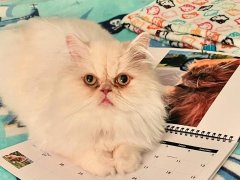
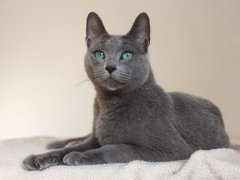


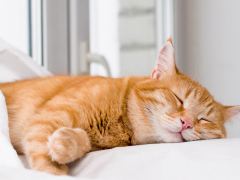

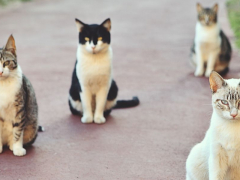
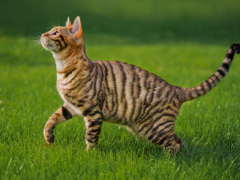
My cat was chewing on one of my plants. It’s not dangerous to him but can you tell me why he would bite on the leafs of the plants.